Difference between revisions of "Leather hair pores - Hair follicles"
| Line 10: | Line 10: | ||
==Leather hair pores - Hair follicle - Leather grain structure== | ==Leather hair pores - Hair follicle - Leather grain structure== | ||
| − | [[Leather]] of the [[Exotic leather|different animal species]] also differs by the hair pore structure, which results from the hair growth. In some animals the hairs grow obliquely, in some cases vertically. In others the hair pores spread evenly over the whole skin, or the hair pores run parallel to the grain pattern. | + | [[Leather]] of the [[Exotic leather|different animal species]] also differs by the hair pore structure, which results from the hair growth. In some animals, the hairs grow obliquely, in some cases vertically. In others, the hair pores spread evenly over the whole skin, or the hair pores run parallel to the grain pattern. |
| − | In DIN EN 15987 (Leather Terminology - Key definitions for the leather trade - July 2015) and RAL 061 A1 (March 2016), the exterior of the leather after removal of the hair with its hair pore structure is called "[[Leather grain - Grain side|grain]]". The [[Bird leather|leather of birds]] has feather | + | In DIN EN 15987 (Leather Terminology - Key definitions for the leather trade - July 2015) and RAL 061 A1 (March 2016), the exterior of the leather after removal of the hair with its hair pore structure is called "[[Leather grain - Grain side|grain]]". The [[Bird leather|leather of birds]] has feather follicles and [[fish leather]] has a scale structure. |
| Line 21: | Line 21: | ||
</p> | </p> | ||
<p align=center> | <p align=center> | ||
| − | ''hair pores - [[Bird leather|feather | + | ''hair pores - [[Bird leather|feather follicles]] - [[fish leather|scale structure]]''<br></p> |
<p> </p> | <p> </p> | ||
| Line 58: | Line 58: | ||
</p> | </p> | ||
<p align=center> | <p align=center> | ||
| − | ''The hair pores in [[sheep leather]] are in rows. The pores are smaller in wool | + | ''The hair pores in [[sheep leather]] are in rows. The pores are smaller in wool sheep skin.''<br></p> |
<p> </p> | <p> </p> | ||
| Line 81: | Line 81: | ||
==fine pore leather - coarse pore leather - fine grain leather - coarse grain leather== | ==fine pore leather - coarse pore leather - fine grain leather - coarse grain leather== | ||
| − | Leather surfaces are sometimes also described as fine-pored or coarse-pored or as fine-grained or coarse-grained. In the case of "fine pores" or "coarse pores", the hair pores are not always clearly defined, which can usually only be seen with the magnifying glass. Usually the total impression of the surface is meant. A [[Water buffalo leather - Buffalo leather|buffalo leather]] surface is "coarse-pored". Not because the hair pores are so big, but because the surface has a [[Leather grain - Grain side|rough structure]]. [[elephant leather]] would be described as "coarse-grained" because of the depth of the [[Leather grain - Grain side|grain]] and not as "coarse-pore". A fine [[Lamb leather - Sheep leather|lambskin]] can be described as fine-grained or fine-pored. Experts such as [[tanner|leather technicians]] will clearly separate the terms. But in general language usage and in advertising, the | + | Leather surfaces are sometimes also described as fine-pored or coarse-pored or as fine-grained or coarse-grained. In the case of "fine pores" or "coarse pores", the hair pores are not always clearly defined, which can usually only be seen with the magnifying glass. Usually the total impression of the surface is meant. A [[Water buffalo leather - Buffalo leather|buffalo leather]] surface is "coarse-pored". Not because the hair pores are so big, but because the surface has a [[Leather grain - Grain side|rough structure]]. [[elephant leather]] would be described as "coarse-grained" because of the depth of the [[Leather grain - Grain side|grain]] and not as "coarse-pore". A fine [[Lamb leather - Sheep leather|lambskin]] can be described as fine-grained or fine-pored. Experts such as [[tanner|leather technicians]] will clearly separate the terms. But in general language usage and in advertising, the porosity is not always associated with the actual size and / or density of the hair pores, but the general "fineness" of the surface is described. |
| Line 92: | Line 92: | ||
</p> | </p> | ||
<p align=center> | <p align=center> | ||
| − | '''''Coarse pore''' leather: [[Water buffalo leather - Buffalo leather|buffalo leather]] - [[Leather saddle#Bicycle saddle|Bicycle saddle]] made of [[cow leather]] - [[ | + | '''''Coarse pore''' leather: [[Water buffalo leather - Buffalo leather|buffalo leather]] - [[Leather saddle#Bicycle saddle|Bicycle saddle]] made of [[cow leather]] - [[Fish leather#Moray eel leather|moray eel leather]]''<br></p> |
<p> </p> | <p> </p> | ||
| Line 140: | Line 140: | ||
</p> | </p> | ||
<p align=center> | <p align=center> | ||
| − | ''[[Leather videos|Video]] about the examination of the [[Porous leather| | + | ''[[Leather videos|Video]] about the examination of the [[Porous leather|porosity]] of [[Smooth leather|smooth leather]].'' |
</p> | </p> | ||
==Embossed hair pores== | ==Embossed hair pores== | ||
| − | Sometimes the hair pores are [[Embossed leather|embossed]] into the leather to make it look natural and also for a valuable appearance. In [[aniline leather]] and [[ | + | Sometimes the hair pores are [[Embossed leather|embossed]] into the leather to make it look natural and also for a valuable appearance. In [[aniline leather]] and [[Semi-aniline|semi-aniline leather]], the natural hair pores are a necessary feature. It often happens that [[Semi-aniline|semi-aniline leather]] is offered, which is none. [[Embossed leather|embossed poors]] are made to copy the desired optics. |
Revision as of 12:42, 4 December 2016
Contents
Leather hair pores - Hair follicle - Leather grain structure
Leather of the different animal species also differs by the hair pore structure, which results from the hair growth. In some animals, the hairs grow obliquely, in some cases vertically. In others, the hair pores spread evenly over the whole skin, or the hair pores run parallel to the grain pattern.
In DIN EN 15987 (Leather Terminology - Key definitions for the leather trade - July 2015) and RAL 061 A1 (March 2016), the exterior of the leather after removal of the hair with its hair pore structure is called "grain". The leather of birds has feather follicles and fish leather has a scale structure.
hair pores - feather follicles - scale structure
The pattern that generate the hair pores, provides additional information about the animal species from which the leather originates. It can also indicate the age of an animal. The number of hair pores in a cattle remains the same throughout their life, which is why they are spread over a wider area in a larger animal. On the same skin surface, calfskins have up to 3 to 3.5 times more pores as on cow hides.
On the cow skin, the hair grow obliquely and evenly distributed.
On buffaloes, the hair grows more vertically. - Peccary always has three pairs of hair pores. - Hair pores of the seal skin.
The hair pores in goat leather are arranged in half-moon-shaped groups.
The hair pores in sheep leather are in rows. The pores are smaller in wool sheep skin.
Also with lambs the hair pores are in rows.
The hair pores can be well seen in a sensitive porous boot leather.
fine pore leather - coarse pore leather - fine grain leather - coarse grain leather
Leather surfaces are sometimes also described as fine-pored or coarse-pored or as fine-grained or coarse-grained. In the case of "fine pores" or "coarse pores", the hair pores are not always clearly defined, which can usually only be seen with the magnifying glass. Usually the total impression of the surface is meant. A buffalo leather surface is "coarse-pored". Not because the hair pores are so big, but because the surface has a rough structure. elephant leather would be described as "coarse-grained" because of the depth of the grain and not as "coarse-pore". A fine lambskin can be described as fine-grained or fine-pored. Experts such as leather technicians will clearly separate the terms. But in general language usage and in advertising, the porosity is not always associated with the actual size and / or density of the hair pores, but the general "fineness" of the surface is described.
Coarse pore leather: buffalo leather - Bicycle saddle made of cow leather - moray eel leather
Coarse grain leather: elephant leather- crocodile leather - cow leather
Als fine pore is called smooth, soft leather without visible pores. Calfskin und lamb leather.
Fine grain is called smooth, soft leather.
On one hide: fine grain - transition - coarse grain.
Porous leather
Leather is also differentiated according to whether it`s "porous" or not. This is the ability to allow moisture to penetrate. Sometimes the breathability of leather is also meant by the ability to absorb moisture. For detailed information see "porous leather".
Video about the examination of the porosity of smooth leather.
Embossed hair pores
Sometimes the hair pores are embossed into the leather to make it look natural and also for a valuable appearance. In aniline leather and semi-aniline leather, the natural hair pores are a necessary feature. It often happens that semi-aniline leather is offered, which is none. embossed poors are made to copy the desired optics.
Sanded, finished and embossed. he hair pores are embossed and not natural.
Sanded, finished and embossed. The hair pores are very plump embossed.
Additional information
- Leather grain - Grain side
- Porous leather
- Breathability of leather
- Top grain leather
- Natural grain
- Embossed leather
- Corrected grain
- Full grain leather








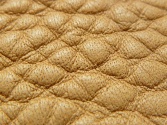
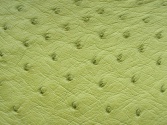
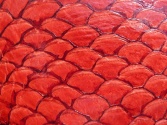



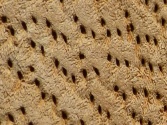
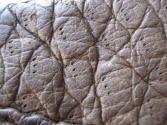
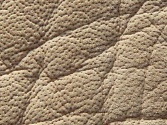



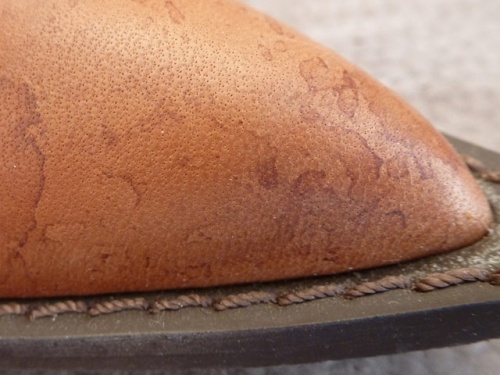



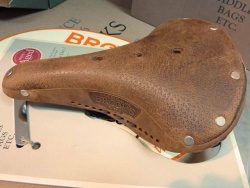











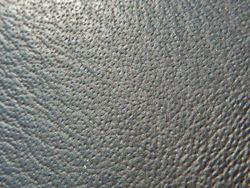
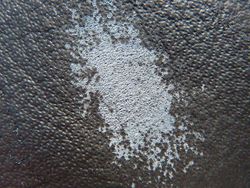



 a kotori web solution
a kotori web solution